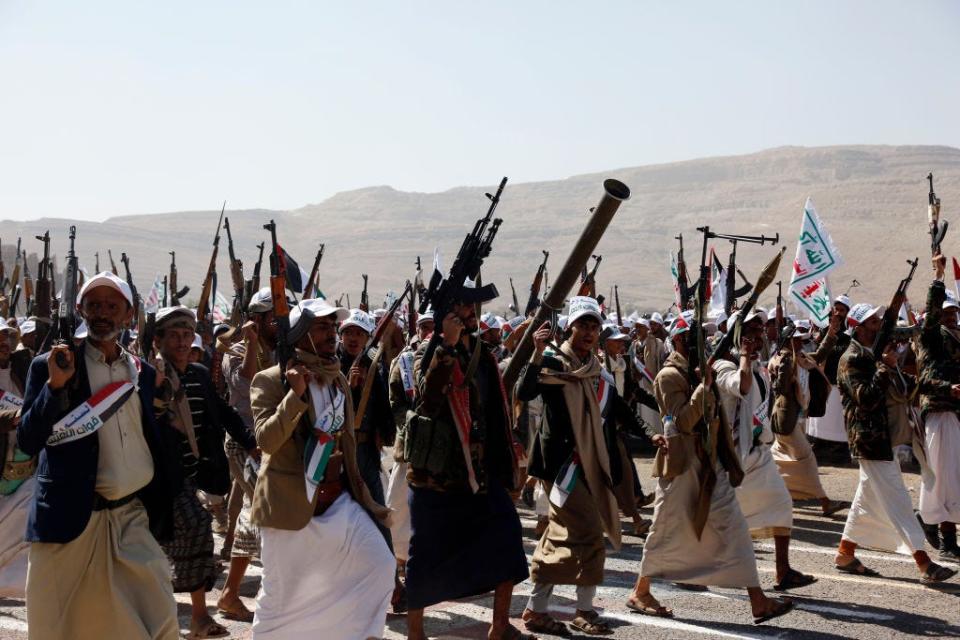US Navy faces 'most intense combat since World War II' against Yemen's Iran-backed Houthi rebels, defense experts say
The US fight against Yemen's Houthis is its toughest fight since WWII, experts told AP.
Houthi attacks on ships in the Red Sea aim to pressure Israel and the West over Gaza.
US strikes recently destroyed Houthi radars as well as sea and aerial drones.
The US is facing its most intense battle since World War II against Yemen's Houthi rebels, experts say.
"We're sort of on the verge of the Houthis being able to mount the kinds of attacks that the US can't stop every time, and then we will start to see substantial damage," Bryan Clark, a former Navy submariner and a senior fellow at the Hudson Institute told the Associated Press.
"If you let it fester, the Houthis are going to get to be a much more capable, competent, experienced force."
"This is the most sustained combat that the US Navy has seen since World War II — easily, no question," he said.
Houthi attacks have been targeting ships in the Red Sea corridor with missiles and drones since October as part of a campaign that aims to put pressure on Israel and the West over the war in Gaza.
Between October 17 and the start of May, the Houthis attacked commercial vessels at least 53 times and have posed a serious threat to naval ships in dozens of other incidents, according to a Congressional Research Service report.
US warships from the US Navy's Dwight D. Eisenhower Carrier Strike Group had fired over 500 munitions fighting the Houthis, Business Insider reported on May 23.
This week, the US attacked several Houthi radar sites in response to recent rebel fire that targeted shipping containers and saw one merchant sailor go missing, authorities said Saturday.
US strikes destroyed seven radars within Houthi-controlled territory, the military's Central Command said.
"These radars allow the Houthis to target maritime vessels and endanger commercial shipping," CENTCOM said in a statement.
US forces also destroyed two Houthi uncrewed surface vessels (USV), or drone boats in the Red Sea, as well as an aerial drone launched from a Houthi-controlled area of Yemen, the statement said.

Director of National Intelligence Avril Haines warned last month that the Houthis were likely to remain active "for some time," and the intensity of the combat shows no sign of letting up.
"I don't think people really understand just kind of how deadly serious it is what we're doing and how under threat the ships continue to be," Cmdr. Eric Blomberg with the USS Laboon told the AP.
Sailors often have only a few seconds to confirm an incoming Houthi strike. They have to quickly confer with other ships and then respond by firing at the incoming missiles and drones.
"It is every single day, every single watch, and some of our ships have been out here for seven-plus months doing that," said Capt. David Wroe, the commodore overseeing the guided missile destroyers, told AP.
This exacting environment has put a financial strain on US resources in the region.
Parts of the Eisenhower strike group have already left the Red Sea once to be rearmed and resupplied, and the Pentagon recently extended its deployment for a second time.
Munitions have cost some $1 billion, Secretary of the Navy Carlos Del Toro revealed in mid-April, a figure that has certainly increased in the two months since.
"I think, unfortunately, the Biden administration has settled into a rhythm where, because of the Houthi attacks on commercial shipping, they feel like they have to do something," Brian Finucane, the senior advisor for the US program at the International Crisis Group, previously told Business Insider.
The Houthis continue to be backed by Iran, and have employed a dangerous mix of anti-ship ballistic and cruise missiles, one-way attack drones, and uncrewed surface vessels.
Earlier this month, the rebels said they had fired a new solid-fuel missile called the "Palestine" at the southern Israeli city of Eilat.
The missile is believed to be able to fly at hypersonic speeds and resembles one unveiled by Iran earlier this year.
Fabian Hinz, a weapons expert at the London-based International Institute for Strategic Studies, wrote on X that the Palestine missile reassembled the Iranian-developed Fattah 1 and the Kheybarshekan 2, both solid-fuel missiles.
Read the original article on Business Insider


